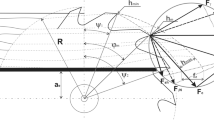Abstract
Cleaving or riving of wood is an efficient method of cutting, but is usually restricted to veneer cutting or low-quality products such as fence-palings, due to the poor surface finish that occurs on thicker offcuts. If the release of strain energy during fracture could be controlled then the surface finish and dimensional tolerance of cleaved wood products would be improved. A series of experiments were carried out on Pinus radiata to split it in the r.l. direction by mode 1 (crack opening) using both single cantilever beam bending and cleaving by a wedge. The offcut thickness, and the blade thickness and grinding angle were varied and the fracture, plastic and friction energies measured. When the offcut was 15 mm or greater the fracture surface energy from both types of cutting were similar and the friction and plastic energies were much larger; all energies were unaffected by blade dimensions? The mode of fracture of the 5 mm offcut was not simple crack opening and consequently the surface energy was a more significant proportion of the total energy, which is why smaller thickness offcuts may be cleaved in a controlled manner.
Zusammenfassung
Spalten oder Brechen ist eine effektive Methode zum Auftrennen von Holz; allerdings ist diese Methode wegen der geringen Oberflächenqualität und der Dicke der Produkte auf minderwertige Furniere und Umkleidungen beschränkt. Wenn man die Freisetzung der Spannungsenergie während des Bruchs kontrollieren könnte, sollten sich Oberflächenqualität und Dickentoleranz der Spaltprodukte verbessern lassen. In einer Reihe von Experimenten wurde Kiefernholz (Pinus radiata) in RL-Richtung gespalten (Mode 1), zum einen durch einfachen Biegebruch zum andern mit Hilfe eines Keiles. Die Dicke der Spaltproben, der Klinge und der Schnittwinkel wurden variiert und die Energie für Bruch, plastische Verformung und Reibung gemessen. Wenn die Spaltprodukte 15 mm oder dicker sind, ist die Bruchenergie bei beiden Verfahren ähnlich, und die Energie für Reibung und plastische Verformung sind größer als die Bruchenergie. Bruch-, Verformungs- und Reibungsenergie waren unabhängig von den Messerdimensionen. Bei Dicken von 5 mm verläuft der Bruch nicht nur durch einfaches Spaltöffnen; daher ist der Anteil der Oberflächenenergie an der Gesamtenergie hier deutlich höher. Dies ist der Grund dafür, daß das Abtrennen dünnerer Spaltprodukte besser kontrolliert werden kann.
Similar content being viewed by others
References
Anonymous (1993) General catalog; Integrated slicer plant. Marunaka Tekkosho Inc. Japan
Ashby MF, Easterling KE, Harrysson R, Maiti SK (1985) The fracture and toughness of woods. Proc. Roy, Soc. Lond. A398: 261–280
Atack D, May WD, Morris EL, Sproule RN (1961) The energy of tensile cleavage fracture of black spruce. Tappi 44: 555–567
Atkins AG, Mai Y-W (1985) Elastic and plastic fracture: metals, polymers, ceramics, composites, biological materials. Ellis-Horwood, Chichester
Boontanjai C (1979) The fracture toughness properties of Pinus radiata. Masters thesis 1979-B64. School of engineering, University of Auckland, NZ
Collins JA (1981) Failure of materials in mechanical design. John Wiley and Sons. New York
DeBaise GR, Porter AW, Pentoney RE (1966) Morphology and Mechanics of Wood Fracture. Materials Research & Standards. 6: 493–499
Franz NC (1958) An analysis of the wood-cutting process. Ph.D. thesis, University of Michigan Press, Ann Arbor
Gibson LJ, Ashby MF (1988) Cellular Solids; Structure and Properties. Pergamon. Oxford
Griffith AA (1921) The phenomena of rupture and flow in solids. Phil. Trans. R. Soc. Lond., A221: 163–198
Gurney C, Hunt J (1967) Quasi-static crack propagation. Proc. Roy. Soc. A299: 508
Hannah J, Hillier MJ (1988) Applied Mechanics 2nd edition. Longman Group UK Ltd
Koch P (1964) Wood Machining Processes. The Ronald Press Co. New York
McKensie WM (1962) The relationship between cutting properties of wood and its physical and mechanical properties. For. Prod. J. 12: 287–294
Ohya S, Ohta M, Okano T (1994) Analysis of cutting energies in slicing along the grain of wood. Mokuzai Gakkaishi 40: 577–583
Pearson RG (1974) Application of fracture mechanics to the study of the tensile strength of structural timber. Holzforschung 28: 11–19
Porter AW (1964) On the mechanics of fracture of wood. For. Prod. J. 14: 325–331
Schniewind AP, Ohgama T, Aoki T, Yamada T (1982) Effect of specific gravity, moisture content, and temperature on fracture toughness of wood. Wood. Sci. 15: 101–109
Smith J, Chui YH (1994) Factors affecting mode 1 fracture energy of plantation-grown red pine. Wood Sci. Technol. 28: 147–157
Triboulot P, Asano I, Ohta M (1983) An application of fracture mechanics to the wood cutting process. Mokuzai Gakkaishi 29: 111–117
Author information
Authors and Affiliations
Rights and permissions
About this article
Cite this article
King, M.J., Vincent, J.F.V. Fracture energy during cleaving of Pinus radiata . Holz als Roh- und Werkstoff 56, 259–265 (1998). https://doi.org/10.1007/s001070050315
Issue Date:
DOI: https://doi.org/10.1007/s001070050315




